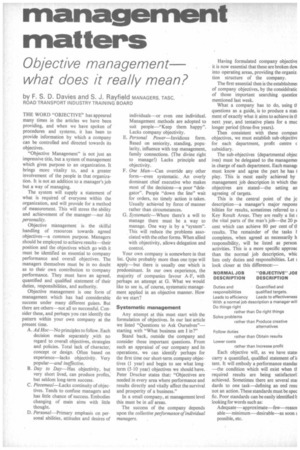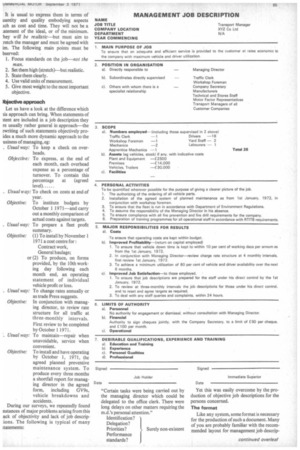management matters
Page 86

Page 87

If you've noticed an error in this article please click here to report it so we can fix it.
Objective management what does it really mean?
by F. S. D. Davies and S. J. Rayfield MANAGERS, TASC, ROAD TRANSPORT INDUSTRY TRAINING BOARD
THE WORD "OBJECTIVE" has appeared many times in the articles we have been providing, and when we have spoken of procedures and systems, it has been to provide information by which a company can be controlled and directed towards its objectives.
"Objective Management" is not just an impressive title, but a system of management which gives purpose to an organization. It brings more vitality to, and a greater involvement of the people in that organization. It is not an addition to a manager's job but a way of managing.
The system will supply a statement of what is required of everyone within the organization, and will provide for a method of measurement. This will stress the ability and achievement of the manager—nor his personality.
Objective management isthe skilful handling of resources towards agreed objectives—a common purpose. Managers should be employed to achieve results—their position and the objectives which go with it must be identified as essential to company performance and overall objectives. The managers themselves must be in no doubt as to their own contribution to -company performance. They must have an agreed, quantified and qualified statement of their duties, responsibilities, and authority.
Objective management is one form of management which has had considerable success under many different guises. But there are others—not all so successful. Consider these, and perhaps you can identify the pattern within your own company at the present time.
A. Ad Hoc--No principles to follow. Each decision made separately with no regard to overall objectives, strategies and policies. Total lack of character, concept or design. Often based on experience—lacks objectivity. Very popular—and ineffective.
B. Day to Day—Has objectivity, but very short lived, can produce profits, but seldom long-term success.
C. Piecemeal—Lacks continuity of objectives. Tends to confuse managers and has little chance of success. Embodies changing of main aims with little thought.
D. Personal—Primary emphasis on personal abilities, attitudes and desires of
individuals—or even one individual. Management methods are adopted to suit people—"Keep them happy". Lacks company objectivity.
E. Personal Power—Invidious form. Based on seniority, standing, popu larity, influence with top management, family connections. (The divine right to manage!) Lacks principle and objectivity.
F. One Man—Can override any other form—even systematic. An overly dominant chief executive who makes most of the decisions—a poor "delegator". People "down the line" wait for orders, no timely action is taken. Usually achieved by force of manner rather than circumstances.
G. Systematic—Where there's a will to manage there must be a way to manage. One way is by a "system". This will reduce the problems associated with the other forms. When allied with objectivity, allows delegation and control.
Your own company is somewhere in that list. Quite probably more than one type will apply—but there is usually one which is predominant. In our own experience, the majority of companies favour A-F, with perhaps an attempt at G. What we would like to see is, of course, systematic management applied in an objective manner. How do we start?
Systematic management
Any attempt at this must start with the formulation of objectives. In our last article we listed "Questions to Ask Ourselves"— starting with "What business am I in?"
Stand back, outside the company and consider these important questions. From such an appraisal of our company and its operations. we can identify perhaps for the first time our short-term company objectives (1 year) and begin to see what longterm (5-10 year) objectives we should have. Peter Drucker states that: "Objectives are needed in every area where performance and results directly and vitally affect the survival and prosperity of a business."
In a small company, at management level this must be in all areas.
The success of the company depends upon the collective performance of individual managers.
Having formulated company objective it is now essential that these are broken dol.; into operating areas, providing the organiz tion structure of the company.
The first essential then is the establish me: of company objectives, by the consideratic of those important searching questior mentioned last week.
What a company has to do, using tt questions as a guide, is to produce a stab ment of exactly what it aims to achieve intl next year, and tentative plans for a muc longer period (three-five years).
Then consistent with these compan objectives, we must establish sub-objectivE for each department, profit centre c subsidiary.
The sub-objectives (departmental objec ives) must be delegated to the managemei in charge of each department. Each manag■ must know and agree the part he has I play. This is most easily achieved by management job description in which the: objectives are stated—the setting an agreeing of targets.
This is the central point of the jc
description a manager's major respons bilities for results, sometimes referred to t Key Result Areas. They are really a list the vital parts of the man's job—the 20 pi cent which can achieve 80 per cent of ti results. The remainder of the tasks I completes, when agreed as necessarily h responsibility, will be listed as person activities. This is a more specific approac than the normal job description, whic lists only duties and responsibilities. Let t look closer at this difference:— NORMAL JOB "OBJECTIVE" JOE
DESCRIPTION DESCRIPTION Duties and Quantified and responsibilities qualified targets.
Leads to efficiency Leads to effectiveness With a normal job description a manager will Do things right rather than Do right things Solve problems rather than Produce creative a ltern atives Follow duties rather than Obtain results Lower costs
rather than Increase profit Each objective will, as we have state carry a quantified, qualified statement of ii tent. It will embody a performance standat —the condition which will exist when ti required results are being satisfactori achieved. Sometimes there are several stai dards to one task—defining an end resu not an action. These standards must be spec fic. Poor standards can be easily identified h looking for words such as: Adequate — approxi mate —few —reasoi able—minimum—desirable—as soon E possible, etc.
It is usual to express them in terms of uantity and quality embodying aspects ich as cost and time. They will not be a atement of the ideal, or of the minimum. hey will be realistic—but must aim to retch the manager and must be agreed with im. The following main points must be bserved: 1. Focus standards on the job—not the man.
2. Set them high (stretch)—but realistic.
3. State them clearly.
4. Use valid units of measurement.
5. Give most weight to the most important objective.
Ihjective approach
Let us have a look at the difference which is approach can bring. When statements of 'tent are included in a job description they re usually rather general in approach—the writing of such statements objectively proides a much more dynamic approach to the usiness of managing, eg: Usual way: To keep a check on overheads.
Objective: To express, at the end of each month, each overhead expense as a percentage of turnover. To contain this percentage at (agreed level) Usual w ay: To check on costs at end of year.
Objective: To institute budgets by October 1 1971—and carry out a monthly comparison of actual costs against targets.
Usual way: To prepare a fleet profit summary.
Objective: (1) To install by November 1 1971 a cost centre for : Contract work, General haulage: or (2) To produce, on forms provided, by the 10th working day following each month end, an operating statement of individual vehicle profit or loss.
Usual way: To change rates annually or as trade Press suggests.
Objective: In conjunction with managing director, to review rate structure for all traffic at three-monthly intervals. First review to be completed by October 11971.
Usual way: To maintain—repair when unavoidable, service when convenient.
Objective: To install and have operating by October 1, 1971, the agreed planned preventive maintenance system. To produce every three months a shortfall report for managing director in the agreed form, including GV9s, vehicle breakdowns and accidents.
During our surveys, we repeatedly found nstances of major problems arising from this ack of objectivity and lack of job descripions. The following is typical of many ;tatements:










































































































































